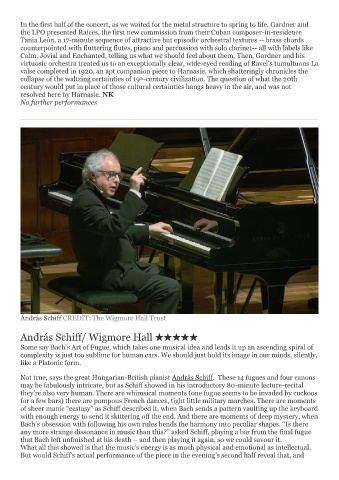Page 237 - Royal Liverpool Philharmonic Coverage Book 2023-24
P. 237
In the first half of the concert, as we waited for the metal structure to spring to life, Gardner and
the LPO presented Raíces, the first new commission from their Cuban composer-in-residence
Tania León, a 17-minute sequence of attractive but episodic orchestral textures -- brass chords
counterpointed with fluttering flutes, piano and percussion with solo clarinet-- all with labels like
Calm, Jovial and Enchanted, telling us what we should feel about them. Then, Gardner and his
virtuosic orchestra treated us to an exceptionally clear, wide-eyed reading of Ravel’s tumultuous La
valse completed in 1920, an apt companion piece to Harnasie, which shatteringly chronicles the
collapse of the waltzing certainties of 19 -century civilization. The question of what the 20th
th
century would put in place of those cultural certainties hangs heavy in the air, and was not
resolved here by Harnasie. NK
No further performances
András Schiff CREDIT: The Wigmore Hall Trust
András Schiff/ Wigmore Hall ★★★★★
Some say Bach’s Art of Fugue, which takes one musical idea and leads it up an ascending spiral of
complexity is just too sublime for human ears. We should just hold its image in our minds, silently,
like a Platonic form.
Not true, says the great Hungarian-British pianist András Schiff. These 14 fugues and four canons
may be fabulously intricate, but as Schiff showed in his introductory 80-minute lecture-recital
they’re also very human. There are whimsical moments (one fugue seems to be invaded by cuckoos
for a few bars) there are pompous French dances, tight little military marches. There are moments
of sheer manic “ecstasy” as Schiff described it, when Bach sends a pattern vaulting up the keyboard
with enough energy to send it skittering off the end. And there are moments of deep mystery, when
Bach’s obsession with following his own rules bends the harmony into peculiar shapes. “Is there
any more strange dissonance in music than this?” asked Schiff, playing a bar from the final fugue
that Bach left unfinished at his death – and then playing it again, so we could savour it.
What all this showed is that the music’s energy is as much physical and emotional as intellectual.
But would Schiff’s actual performance of the piece in the evening’s second half reveal that, and

